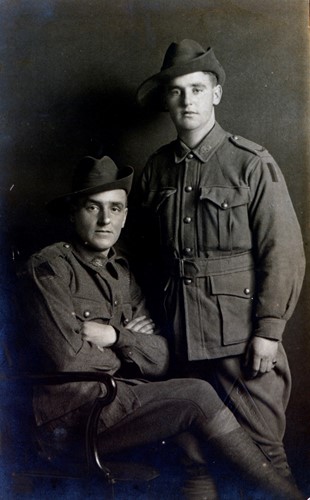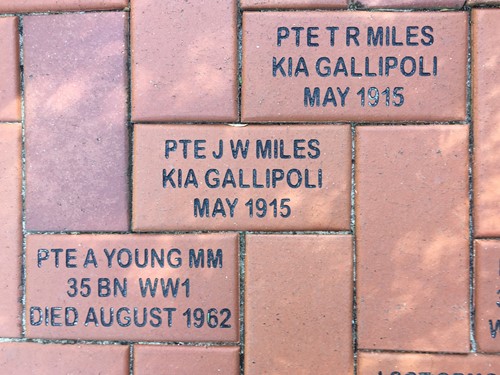Andy Young was born in Sydney and grew up in Balmain. He was the youngest of 10 children and training to be an engineer with the PMG (now Telstra) when World War I broke out. He was only 17 when he enlisted, and written permission from his parents was required. They knew that he was likely to run away and join up in another city under another name, so they signed the necessary papers. Andy enlisted in the 35th Battalion which was deployed to France after training. There, the battalion was engaged in heavy action and suffered many casualties. Andy fought in the trenches, was gassed twice and shot in the arm. That injury, suffered in 1918, ended his war service. Before he was wounded he was recommended for the Military Medal for gallantry. The citation, framed after the War and now hanging on my wall, says that he was a runner who delivered a series of messages for a Lt Connor under heavy fire.
Andy survived the war. While recuperating in England he met and married a young nurse who accompanied him back to Australia when he recovered. Sadly, she died of Spanish flu in 1919 or 1920. He never spoke of her, and the few sketchy details available came from one of his sisters-in-law. No known photographs or documents such as a marriage certificate survive. Andy returned to work for the PMG, qualified as an engineer and had a long and successful career. One of the more interesting highlights was while he worked with the Americans during World War II on the establishment and maintenance of secure communication systems. The Americans, in his words, "wanted everything done yesterday". He married again in 1929 and had two daughters, one of whom was my mother. He died of a heart attack in 1962.
I was just five years of age when Andy died, so never really knew him well, but have some fleeting, pleasant memories of him. Apparently, not unusual for ex-servicemen, he never spoke at any length about his war service and, though a member, was not actively involved in the RSL. He did tell a couple of amusing anecdotes which have been passed down in the family. One concerned his brief promotion from Private to Lance Corporal during training. Unfortunately, he was a little too young to take the responsibility seriously; he was caught sitting around smoking with his men when he was supposed to be training them and was demoted back to Private. The other concerned the capture of a number of German soldiers. One of these was a Prussian officer who was very arrogant and refusing to line up with "common soldiers". The Aussie diggers, ever egalitarian, were having none of that and roughly shoved him into line with the rest. The story goes that the German troops loved seeing their arrogant officer cut down to size and were surreptitiously smiling and winking at the Aussies.

One of Andy's brothers, Jack, who was a few years older, also joined up. He also survived the War. He moved rapidly through the ranks and held the rank of Warrant Officer Class II at the end of the War. The two brothers (pictured above) never served together, but did meet up on a couple of occasions. The story goes that Andy had to line up with the other soldiers outside the office of a very scary Sergeant Major Jack Young to see his brother. Jack was physically uninjured but mentally scarred by the War. His recovery, eventually complete, took a couple of years. His wife, talking about it after his death, always surmised that the responsibilities of his rank had been particularly burdensome. Undoubtedly, having to select who should be chosen for a task which could end in a violent death would have taken its toll on him. He served throughout the War. I never knew him, but my mother and other relatives always spoke of him with great affection.
A photograph of the paver I purchased for Andy is shown below. It is placed alongside the pavers I purchased for Tom and Jack Miles, two of my granduncles. I intend to purchase one for my other granduncle, Jack Young, when I can learn more of his War Service.

Article was originally published on 12 October 2020.

 Our places
Our places  Chowder Bay
Chowder Bay









